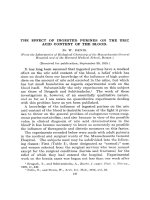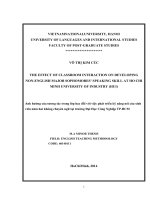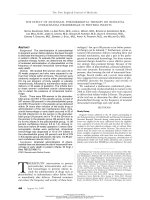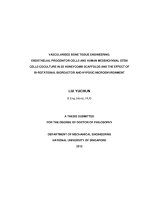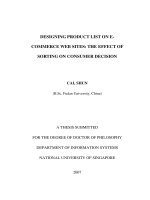- Trang chủ >>
- THPT Quốc Gia >>
- Hóa
The effect of forces
Bạn đang xem bản rút gọn của tài liệu. Xem và tải ngay bản đầy đủ của tài liệu tại đây (4.66 MB, 14 trang )
Genre
Nonfiction
Comprehension Skill
Predict
Text Features
•
•
•
•
Captions
Charts
Diagrams
Glossary
Science Content
Forces and Motion
Scott Foresman Science 6.15
ISBN 0-328-14013-9
ì<(sk$m)=beabdi< +^-Ä-U-Ä-U
Vocabulary
acceleration
force
friction
gravitational force
inertia
momentum
speed
velocity
What did you learn?
1. Put the planets in order by gravitational force,
starting with the least gravitation.
2. A woman is driving a car. She then fills her car
with heavy boxes. It now takes more force for
the car to accelerate. This is an example of which
of Newton’s laws of motion?
by Natalie Rompella
3. Why is there high tide on the side of Earth facing
the Moon?
Picture Credits
Every effort has been made to secure permission and provide appropriate credit for photographic material.
The publisher deeply regrets any omission and pledges to correct errors called to its attention in subsequent editions.
Photo locators denoted as follows: Top (T), Center (C), Bottom (B), Left (L), Right (R), Background (Bkgd).
1 ©Rubberball Productions; 3 (CR) Getty Images; 6 (B, CR) ©Rubber Ball Productions; 10 ©Comstock Inc.;
12 John Shaw/NHPA Limited; 15 Getty Images; 17 Royal Society/Eileen Tweedy/The Art Archive; 18 (TR) Dean Conger/
Corbis, (B) Pete Stone/Corbis; 20 Srdjan Mihic/Alamy Images; 21 (TR) Getty Images; 22 Getty Images.
Scott Foresman/Dorling Kindersley would also like to thank: 23 NASA/DK Images.
Unless otherwise acknowledged, all photographs are the copyright © of Dorling Kindersley, a division of Pearson.
ISBN: 0-328-14013-9
Copyright © Pearson Education, Inc. All Rights Reserved. Printed in the United States of America.
This publication is protected by Copyright, and permission should be obtained from the publisher prior to any
prohibited reproduction, storage in a retrieval system, or transmission in any form by any means, electronic,
mechanical, photocopying, recording, or likewise. For information regarding permission(s), write to
Permissions Department, Scott Foresman, 1900 East Lake Avenue, Glenview, Illinois 60025.
3 4 5 6 7 8 9 10 V010 13 12 11 10 09 08 07 06 05
4.
Is it harder to stop your bike
on concrete than on ice? Why?
5.
Predict Choose a sport to discuss how it uses
gravity, speed, velocity, friction, and acceleration
as part of the game.
The Nature of Forces
How many objects do you apply force to every day? Do you
ever push a door open? Do you grab or pull any objects? When
you push or pull something, you are applying force. Force is a
push or pull.
Forces push or pull not only when objects touch, but even
when they do not. Have you ever held two magnets near each
other and then let go of one? The magnets may have attached to
each other. The magnetic pull was the force that pulled and held
them together.
When you hit a ball with a bat, you are actually pushing it.
If gravity did not pull the ball down, it would never “fall” on
the ground, or it would be very difficult to catch.
push force
pull of gravity
2
Applying Forces
Objects receive force from many different directions.
They also apply force on other objects. What determines
how something moves? The greater force causes an object to
move. If it receives the same amount of force in opposing
directions, it will not move.
If two people of the same mass push with the same force
on opposing sides of a box, the box will not move. If one of
the two people applies more force, measured in newtons (N),
the box will move away from him or her.
If you have ever built anything
with wood, you may have held the
pieces together with nails. As you
applied force to the nail with a
hammer, the force pushing the nail
down was greater than the force of
the wood pushing back, and the
nail moved into the wood.
The force exerted on the
nail by the hammer is
greater than the force of
the wood pushing back.
exerting a force on a tennis ball
3
Understanding Friction
Using and Avoiding Friction
Let’s say you take off your shoes before going into the kitchen.
As you walk over to the refrigerator in your socks, you slip on the
floor. Why? The flat surface of the kitchen floor and the smooth
surface of your socks cause little friction with each other.
Friction is the force that keeps objects from moving
past one another. Now think what it would be like
to ski with too much friction. Your skis would
not slide past the snow easily and you would
not ski very quickly.
What happens if you decide to walk in your
socks on the carpet? You probably will slide
less than you did on the smooth kitchen
floor. The carpet’s rougher surface
creates more friction with your
socks. The type of friction that
the carpet and your socks make
with each other is called sliding
friction.
There are two other types of
friction: rolling friction and static
friction. Rolling friction resists an
object from rolling over a surface or
other object, such as trying to inline
skate on a carpet. Static friction resists
an object from beginning to move,
such as trying to slide your bed or
another piece of furniture across
a room. Once you get it moving,
it becomes easier.
You rely on friction every day. When you wash your hands,
the soap helps to kill germs, but the motion of rubbing your hands
together also creates friction, which helps to get rid of germs.
People who play stringed instruments, such as violins and
cellos, know that friction can be a good thing. Before playing the
instrument, they rub a special substance, called rosin, on the bow.
Rosin is made from tree sap and makes the bow stickier, creating
more friction with the strings. Gymnasts also use rosin on their
hands to help keep their grip, especially on the uneven bars,
balance beam, and parallel bars.
Can friction be harmful? Did you ever get a blister from a pair
of shoes? The shoes rubbing against your feet, or the friction
between your shoes and skin, caused the blister. Have you ever seen
potters making a clay pot? They allow the clay to spin as they work
it with their hands.
They keep their hands
moist with water to
avoid friction. They
want their hands to
easily slide across the
surface of the clay to
smooth it into a
particular shape.
Friction is essential
for ice skating.
4
This potter is keeping
his hands moist to
avoid friction.
5
Sun
Gravitational Force
Universal Force
The force of attraction that is experienced by all the objects
in the universe is gravitational force. Gravity is the gravitational
force on Earth. Jump up. If you try to stay up in the air, you can’t.
Why? Gravity pulls you toward the surface of Earth. Gravity holds
the water in the oceans and holds the air near Earth. Gravity has an
effect on the growth of plants. Life depends on gravity in many
ways. Earth is not the only source of gravity, however; there are
other gravitational forces in the universe.
In the 1600s, Sir Isaac Newton
discovered the properties of gravity.
He explained that gravity depends on the
masses of the objects. Objects with greater
mass exert more gravity on objects that have
smaller mass. The magnitude of the force not
only depends on the mass of the objects, but
also on the distance between the two objects.
When you jump up into the air, you pull on
Earth with gravitational attraction. The Earth is
also pulling on you. Because Earth has a much
greater mass than you do, its gravitational
attraction is stronger, pulling
you back to the ground.
At a higher altitude,
gravity is slightly less.
Newton was the first to realize that the
force holding any object to Earth is the same
as the force holding the universe together.
Which do you think has a greater
gravitational force, Earth or the Moon?
Because Earth has a larger mass, the Moon is
pulled toward Earth and orbits Earth. Which
do you think has a greater gravitational
force, Earth or the Sun? The Sun has a much
greater mass than Earth and all of the other
planets in the solar system. That is why the
planets revolve around the Sun. They are being
pulled toward the Sun as they orbit it.
Also, each of the planets has a specific
gravitational pull. Although your mass would
not change if you traveled to different planets,
your weight would. That is because weight is a
measure of a planet’s gravitational pull on you.
Weight in the metric system is measured in
newtons. If your mass is 50 kilograms, your
weight is 490.3 newtons on Earth.
Pluto
Neptune
Uranus
Saturn
Jupiter
Mars
Earth
Venus
Mercury
When you jump,
Earth’s gravity pulls
you back down.
6
The Moon is pulled toward Earth
because Earth has a greater mass.
7
The Effects of Gravity
Journey to the Planets
Planet
Weight in
Newtons (N)
Weight in
Pounds (lb)
Mercury
185.3
41.7
Venus
444.7
100
Earth
490.3
110.2
Mars
184.9
41.6
Jupiter
1,159.1
260.6
Saturn
521.7
117.3
Uranus
435.9
98
Neptune
551.6
124
Pluto
32.9
7.4
The table above shows the weight of a child
who has a mass of 50 kilograms. The differences
in weight are due to the fact that every planet has
a specific gravitational force. If she could weigh
herself on each of the planets, her weight in
newtons would change due to the differences
in gravitational force on each planet.
If walking on the Moon, she would
weigh 83.5 newtons, or 18.8 pounds!
The Moon’s gravity is about one-sixth
the gravity on Earth.
Have you ever looked at the shoreline by the ocean?
Sometimes there is a lot of beach and other times at the same
place there is less. This is because the level of the ocean water
varies over the course of a day. This is due to gravity.
Both the Earth and the Moon have strong gravitational
attraction. The Moon’s gravitational attraction causes water to
be pulled away from the Earth toward the Moon. When this
happens, we experience high tide on that side of the Earth.
At the same time, the side of Earth opposite the Moon also
experiences high tide. The Moon does not have as strong a pull
on the opposite side of the Earth; rather, this bulge of water is
caused by the movement of the Earth. While the sides toward
the Moon and opposite the Moon are experiencing high tide,
the two sides in between are experiencing low tide.
Tides are caused by the Moon’s gravity
pulling on Earth’s water.
This suitcase would weigh
six times less on the Moon!
8
9
Describing Motion
Kinds of Motion
Have you ever been sitting in a car at a stoplight when the car
next to you slowly starts to move, and it’s hard to tell whether
you are in motion or the other car is in motion? If you look at
a nearby tree or street sign, you can tell which is really moving.
An object that can be used to detect motion is called a frame
of reference.
Usually, Earth is used as the frame of reference for motion.
When on Earth, one can tell which object is moving in relation to
Earth. But isn’t Earth moving? It is, but we are moving with it.
At dusk many people will sit outside to watch the Sun “set.”
In reality, Earth is rotating away from the direction of the Sun,
making the Sun seem to disappear and then reappear at dawn.
Objects can move in many directions. Motion can be straight,
zigzag, curvy, or even up and down. Trains and airplanes move
mostly in straight lines. Many sports use straight motion. Golfers
usually try to hit the ball so that its motion is straight. When you
bowl, the ball rolls down the lane in a straight line too.
A zigzag motion is moving in a line that sharply and repeatedly
changes direction. Some skiers train to move very fast through
gates that are positioned in a zigzag pattern. Some skillful skiers
are able to do this easily.
A curvy motion is traveling in a line that is not straight, but
moves in a smooth, continuous fashion, such as walking up a
spiral staircase. If you’ve ever watched cars race on a circular track,
you may have described the cars’ motion as curved. However, from
the frame of reference of the drivers in the car, they would
probably describe the road’s motion as curved.
Think of a child on a seesaw. The movement is up and down.
To the child on the seesaw, the ground is moving up and down.
To someone watching the child on the seesaw, the seesaw is
moving up and down.
Although it may appear that the Sun is setting,
Earth is actually rotating away from the Sun.
Skiers move in a
zigzag motion.
10
11
Calculating Speed
An object in motion moves at a certain pace in a given time.
Speed is a measure of how fast an object is traveling. If you run
one kilometer in ten minutes, your speed would be calculated by
dividing the distance by the time. Usually speed is measured in
kilometers per hour (km/h). To calculate speed in kilometers per
hour (km/h), first calculate the speed in kilometers per minute
(km/min) and then multiply by 60.
Distance (1 km)/Time (10 min) = Speed (0.1 km/min)
x 60 = 6 km/h
Your average speed would equal 6 km/h. However, you
probably would not run at a constant pace of one kilometer for
every ten minutes. There would probably be points when you
would run a little faster or slower. The speed that you are traveling
at the exact moment is your instantaneous speed.
Animals travel at different speeds. One of the fastest land
animals is the cheetah. Cheetahs can run as fast as 100 km/h.
Peregrine falcons are able to dive down to catch prey at a top
speed of 440 km/h. Snails, on the other hand, travel only
0.048 km/h, making them one of the slowest animals in the
world. Greyhounds, zebras, ostriches, and gray foxes all move
at about the same speed of 64 km/h. Although cockroaches
are small, they are known for being quick. They can travel 5 km/h.
Some of the fastest humans are able to run at speeds of 37 km/h.
Through the years, humans have tried to decrease the time it takes
to travel by creating machines with faster speeds. More than two
hundred years ago, the first steam locomotive was invented. Since
then, automobiles, airplanes, and rockets have been created. One of
the Wright brothers’ original airplanes flew at a top speed of 68 km/h.
Today airplanes are able to travel at speeds of more than 1,000 km/h.
Cheetahs can run very
fast, but only for a
short amount of time.
12
13
Finding Velocity
Car 1
Many objects can move at many
Car 2
speeds and in many directions.
Velocity is the speed and direction of
a moving object. A car traveling from
New York to California may have a
Car 1: velocity = 80 km/h east
velocity of 80 km/h west. On the
Car 2: velocity = 80 km/h west
return to New York, it may have
a velocity of 80 km/h east.
The velocity of an object not
traveling in a straight line will
constantly change. Think of a snake
that slithers in a curvy line. Although its
speed remains constant, its velocity changes
each time it switches directions.
The wind can change the velocity
of an object. If you’ve ever flown a kite,
you’ve seen how both the speed and
direction of the kite can change.
Sailors rely on the wind to navigate
their sailboats across the water.
They need to know the direction
and speed of the wind to
arrive at their destination.
Acceleration
Do you like to ride your bike? As you begin pedaling,
you apply force to the pedals, and you begin to accelerate.
Acceleration is the rate at which the velocity changes.
Acceleration can be both increasing and decreasing velocity.
You come to a busy street, so you apply the brakes, causing
friction between your brakes and the tires and between the tires
and the road. As the bike slows down, your velocity decreases over
a period of time. A decrease in velocity is called deceleration.
The velocity of an object only changes if a force acts on the
object. If you roll a ball across a floor, eventually the velocity and
speed of the ball will decrease. Gravity and friction, among other
forces, will slow the ball down. If you roll a ball down a hill, the
velocity will change, and the ball will accelerate due to the force
of gravity.
When you apply force
by pedaling, you are
accelerating.
The force of the wind against
the sail helps the sailboat to
move through water. By rotating
the sail, the sailboat’s direction
and speed can be changed.
14
15
Studying Motion
First Law of Motion
During the second century A.D. an astronomer named
Claudius Ptolemy believed that the planets and the Sun circled
around Earth. It was not until the 1500s that another scientist,
Nicolaus Copernicus, came up with a different theory. He
believed that the planets, including Earth, circled around the Sun.
Through the years, scientists have studied force and motion.
Many scientists have conducted experiments to help figure out
their theories. Some of the major scientists who have worked on
force and motion are Galileo Galilei and Isaac Newton. Galileo
studied the properties of gravity. Newton is known for the three
laws of motion.
If you set a book on a stationary
surface, such as a table, it will remain there
(assuming no other forces act on it). If you
push the book with your hand, the book
will move across the table. This is what
Newton named the first law of motion.
An object will remain at rest unless acted
on by an unbalanced force.
The opposite is also true. An object
will remain in motion unless acted on by
an unbalanced force. A child on a swing
will keep swinging until a force, such as
gravity, stops the swing. Another force
Isaac Newton
that can change the motion is friction.
Inertia is another name for the first
law of motion. Inertia is the tendency
of an object to remain at rest or in a
continuous motion unless a force acts
upon it.
The mass of an object can affect its
inertia. If you set one textbook on your
desk, you can easily push it to the other
side of your desk. If you were to stack ten
textbooks on top of one another and try
to push them, it would be more difficult.
The stack of ten textbooks has a greater
inertia, making it harder to move.
Earth and other planets revolve around the
Sun due to the Sun’s gravitational attraction.
Mars
Venus
Mercury
Neptune
Uranus
Saturn
Jupiter
the Sun
Earth
Pluto
16
17
Second Law of Motion
Using an Equation
A child can easily pull a wagon.
What if the wagon were filled with
heavy rocks? It would be more
difficult for the child to pull it. This
is Newton’s second law of motion.
The acceleration of an object
depends on the mass of the object
and the amount of force applied.
In the wagon example, the mass of
the wagon changes when rocks are
added. To move the wagon, more
force is needed. If an adult helped
to pull the wagon, more force
could be applied, increasing the
acceleration of the wagon.
To find the acceleration of an object, divide the force
by the mass. Force can be measured in newtons.
Acceleration = Force/Mass
More force is needed to move
heavy objects, such as this jeep
stuck in snow.
If a child uses a force of 10 newtons to pull a wagon with
a mass of 23 kilograms, the acceleration would be 0.43 m/s2.
The direction of the acceleration depends on where the
unbalanced force is coming from.
In a game of tug-of-war, each team depends on its collective
mass and force to help pull the opposite team forcing it to cross
the line dividing them. Whichever team exercises a much greater
force will achieve a greater acceleration, which will cause the other
team to move in the direction of that unbalanced force and cross
the line.
The team causing the greatest acceleration
forces the other team to cross the line.
18
19
Third Law of Motion
What makes trampolines so much fun? They put into practice
Newton’s third law of motion. When a force is applied to an
object, the object exerts an equal force in the opposite direction.
You push down on the trampoline, and then bounce back up in
the opposite direction. Stretching a rubber band and releasing it is
another example of this law. As you pull the rubber band, you are
exerting a force on it. As you let go, the rubber band flies off in
the opposite direction from which you pulled it.
Try to jump straight up in the air without bending your knees.
Were you able to jump very high? Now bend your knees before
jumping. Did you get any higher? Dancers know the importance
of the third law of motion. Before they jump high into the air,
they bend their knees. This force in the opposite direction helps
them jump higher.
Basketball players also use this law
to help them slam-dunk. They run, bend
their knees, jump, and go soaring toward
the basket. The basketball, too, is an
example of the third law of motion. As
the player dribbles the ball (applying force
to it), the ball rebounds off the floor and
bounces back up to the player’s hand.
This law is also called the law of
action and reaction. An action, such as
throwing a ball at a brick wall, causes
a reaction: the ball bounces back.
Because the wall has a greater
mass than the ball, the ball
bounces back and the wall
hardly moves. If a ball is
thrown at a glass bottle,
such as at a carnival
event, the glass bottle
may be knocked down
if the ball has a greater
mass than the bottle.
Basketball players use the
third law of motion to help
them jump high into the air.
The law of action and
reaction can be seen
when a basketball player
dribbles the ball.
Bending your knees before jumping will help you jump higher.
20
21
Momentum
The Universe in Motion
After a batter hits a baseball, the player’s body continues
to swing around. Why? The amount of force needed to stop the
ball and make it go in the opposite direction takes momentum.
Momentum depends on the mass and velocity of an object. The
mass of the bat and the direction and speed of the hit need to be
greater than the mass and velocity of the ball. When objects collide,
the total momentum before the collision equals the total momentum
afterward, known as the law of conservation of momentum. The
total momentum before the batter hits the baseball equals the total
momentum after. The more momentum the ball being pitched has,
the harder it is for the batter to hit the ball to make it first stop,
and then change its direction.
A force is a push or a pull. We can measure force and identify
its direction. Some forces act only if the objects touch, such as
when you hold a book in your hand. Other forces act even if the
objects do not touch. Earth’s gravity pulls you down when you
jump. Friction is the force that resists the movement of an object
over the surface of another.
Gravitational force is the force of attraction between objects
in the universe. Every planet and moon has a different gravitational
force. The force depends on the size and mass of the object.
Gravity on the Moon is much less than on Earth because the
Moon is smaller.
Motion is described using a frame of reference. You are not in
motion relative to Earth when you are sitting quietly. But because
Earth moves in space and also rotates on its axis, you are moving
with Earth relative to the Sun.
If an object moves faster or slower, the change in velocity is
called acceleration. Motion can be described by specific laws.
Newton’s laws explain how things move in the universe.
The law of momentum can be
seen in action when a baseball
player hits a ball.
Though we do not notice
it, the Earth moves through
space at a speed of 29.8
kilometers per second.
22
23
Vocabulary
Glossary
acceleration
force
acceleration
rate at which velocity changes
friction
gravitational force
force
a push or pull
inertia
momentum
friction
force that keeps objects from moving past
speed
one another
velocity
gravitational force attraction between any object and every
other object in the universe
What did you learn?
1. Put the planets in order by gravitational force,
starting with the least gravitation.
2. A woman is driving a car. She then fills her car
with heavy boxes. It now takes more force for
the car to accelerate. This is an example of which
of Newton’s laws of motion?
3. Why is there high tide on the side of Earth facing
the Moon?
inertia
tendency of an object to remain at rest or
in constant motion unless a force acts on it
4.
Is it harder to stop your bike
on concrete than on ice? Why?
momentum
product of an object’s mass multiplied
by its velocity
5.
Predict Choose a sport to discuss how it uses
gravity, speed, velocity, friction, and acceleration
as part of the game.
speed
measure of how fast an object is traveling
velocity
speed plus direction of an object
Picture Credits
Every effort has been made to secure permission and provide appropriate credit for photographic material.
The publisher deeply regrets any omission and pledges to correct errors called to its attention in subsequent editions.
Photo locators denoted as follows: Top (T), Center (C), Bottom (B), Left (L), Right (R), Background (Bkgd).
1 ©Rubberball Productions; 3 (CR) Getty Images; 6 (B, CR) ©Rubber Ball Productions; 10 ©Comstock Inc.;
12 John Shaw/NHPA Limited; 15 Getty Images; 17 Royal Society/Eileen Tweedy/The Art Archive; 18 (TR) Dean Conger/
Corbis, (B) Pete Stone/Corbis; 20 Srdjan Mihic/Alamy Images; 21 (TR) Getty Images; 22 Getty Images.
Scott Foresman/Dorling Kindersley would also like to thank: 23 NASA/DK Images.
Unless otherwise acknowledged, all photographs are the copyright © of Dorling Kindersley, a division of Pearson.
ISBN: 0-328-14013-9
Copyright © Pearson Education, Inc. All Rights Reserved. Printed in the United States of America.
This publication is protected by Copyright, and permission should be obtained from the publisher prior to any
prohibited reproduction, storage in a retrieval system, or transmission in any form by any means, electronic,
mechanical, photocopying, recording, or likewise. For information regarding permission(s), write to
Permissions Department, Scott Foresman, 1900 East Lake Avenue, Glenview, Illinois 60025.
3 4 5 6 7 8 9 10 V010 13 12 11 10 09 08 07 06 05
24




